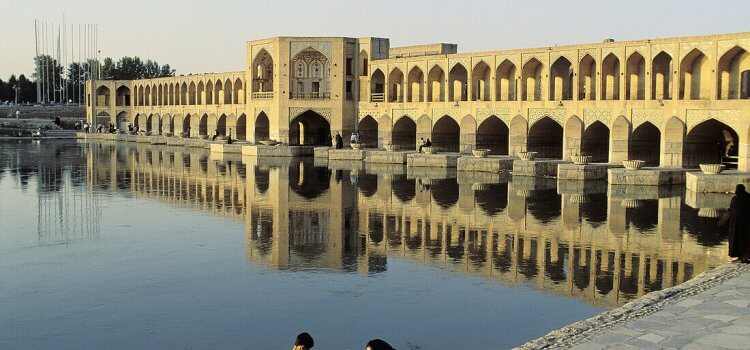The Only Bridge Decorated with Haft-Rangi Tiles in Iran
If you come to Isfahan and ask people about the tourist attractions in and around the city, you will surely be recommended to visit Khaju Bridge over and over again. But why?
Well, Khaju Bridge is a multi-purpose bridge built by the order of Safavid king, Shah Abbas II, about 350 years ago. This old but invincible bridge has won the heart of people of Isfahan for several different reasons. First of all, its beauty is exemplary, being the only bridge decorated with haft-Rangi tiles in Iran. From afar, it lies in front of you like a half-drown, charming Persian girl. Standing in one of its vaulted niches, it seems as if the bridge magically directs your eyes toward the most beautiful scenes in Isfahan.
Also, it is filled with positive vibe, energizing and mesmerizing people for hundreds of years. From the time of Shah Abbas II, Khaju bridge has been a place of celebrations, public meetings, public concerts and, generally speaking, a refuge from the burden of everyday life.
Now, let’s delve a bit more into architecture and history to appreciate as much as possible the beauties of Khaju Bridge.
The History of Khaju Bridge
Years before the Safavids choosing Isfahan as the seat of their power (at the beginning of 17th century), there was a bridge on the eastern bank of Zayandeh-Rood River, connecting the city to the road which led to the city of Shiraz. This 15th bridge was built by the order of Hasan Pasha or Hasan Beik, a Timurid governor, and so was known as Hasan Abad Bridge.
But about 200 hundred years later, the Safavid king Shah Abbas II decided to build a totally new bridge over the foundations of Hasan Abad Bridge. So, architects, masons and construction workers rolled their sleeves up and built a bridge which matched the burning desires and cravings of the king.
The author of the book “Ghesas al-Khaqani” (Kings’ Tales) tells the story of the inauguration of the bridge as follows: in the year 1650, after Nowruz (Persian New Year) vacations, Shah Abbas II ordered the inauguration of the bridge. Accordingly, the bridge was decorated, covered with flowers and lighted with numerous lamps. In addition, each one of its rooms was decorated by a certain dignitary. And, in this way, Khaju Bridge was opened to the public.
However, you should know that the bridge was first known as Pol-e Shahi (or Royal Bridge). Then, it became famous as Khaju Bridge. But, what does Khaju mean?
Khaju Bridge? What does Khaoo mean?
The word Khaju is derived from Khajeh, a title used for courtiers and those close to the royal family. Now, since these courtiers were living in a neighborhood close to the Royal Bridge, the bridge also came to be known as Khaju, although with a bit of phonological change.
The Architecture of Khaju Bridge
Khaju Bridge is 133 m long, 12 m wide and includes 23 arches. is a double-decker bridge. The upper storey includes a main passageway which was used by caravans and two covered corridors, on both right and left sides, for pedestrians. The lower part of the bridge was used only by pedestrians, as a rendezvous for friendly meetings and a center of recreation.
As mentioned before, Khaju Bridge served different function and purposes. Firstly, it was used as a dam to regulate the flow of water of the Zayandeh-rud. When the 21 lower sluices were blocked by wooden panels fitted into stone grooves, the level of water behind this man-made dam increased substantially. The surplus water gathered by this engineering trick was used to fill the underground reservoirs and to irrigate the gardens built along the banks of the river. Also, by closing sluice gates, an artificial lake was formed on the Western side of the bridge at the time of festivals. In this way, the river welcomed the many boats which sailed through it during various celebrations. Fireworks, and their reflection in the water, also enhanced the spectacle.
Now, lets go to the upper storey. As we have mentioned before, the false-arches on the inner side of the bridge are decorated with haft-rangi tiles, a unique feature not enjoyed by any other bridge in Iran. In the middle of the western and eastern sides of the bridge, there are two pavilions known as Shah-Neshin. Each one of these Shah-Neshins is comprised of a large room overlooking three balconies. All of these rooms and balconies are decorated with murals from the Qajar period, painted over those from the 17th century Safavid era.
Looking down on the stone foundations and the flowing water from these rooms gives one the impression of being on a boat sailing through the river. During a flood, the conical-shaped stone structures on the lower and upper storeys helped water pass through the bridge, and thus prevented any damage to the bridge itself.

